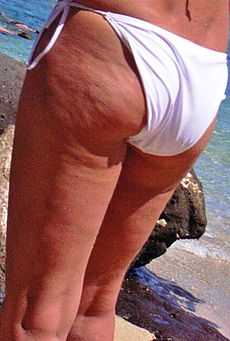Cellulite
- This article is about the dimpled appearance of skin. For the infection of skin and its underlying connective tissue, see cellulitis. Not to be confused with Celluloid.
| Cellulite | |
|---|---|
 The dimpled appearance of cellulite | |
| Classification and external resources | |
| MedlinePlus | 002033 |
Cellulite (also known as adiposis edematosa, dermopanniculosis deformans, status protrusus cutis, gynoid lipodystrophy, and orange peel syndrome) is the herniation of subcutaneous fat within fibrous connective tissue that manifests topographically as skin dimpling and nodularity, often on the pelvic region (specifically the buttocks), lower limbs, and abdomen.[1][2] Cellulite occurs in most postpubescent females.[3] Although cellulite is a form of fat, its causes and cures have little to do with diet, exercise or lifestyle. It can result from a complex combination of factors ranging from hormones to heredity.
History
The term was first used in the 1920s by spa and beauty services to promote their services, and began appearing in English language publications in the late 1960s, with the earliest reference in Vogue magazine, "Like a swift migrating fish, the word cellulite has suddenly crossed the Atlantic."[4] Its existence as a real disorder has been challenged,[5] and the prevailing medical opinion is that it is merely the "normal condition of many women".[6] The prospect of sales creates an incentive for disease mongering. Based on recent research, it is more likely that cellulite is a natural part of the human body than a disease.
Causes
The causes of cellulite[7] include changes in metabolism, physiology, dieting too hard or too much, sex-specific dimorphic skin architecture, alteration of connective tissue structure, hormonal factors, genetic factors, the microcirculatory system, the extracellular matrix, and subtle inflammatory alterations.[1][3][7][8]
- Hormonal factors
Hormones play a dominant role in the formation of cellulite. Estrogen may be the important hormone to initiate and aggravate cellulite. However, there has been no reliable clinical evidence to support such a claim. Other hormones, including insulin, the catecholamines adrenaline and noradrenaline, thyroid hormones, and prolactin, are all believed to participate in the development of cellulite.[1]
- Genetic factors
There is a genetic element in individual susceptibility to cellulite.[1] Researchers led by Enzo Emanuele have traced the genetic component of cellulite to particular polymorphisms in the angiotensin converting enzyme (ACE) and hypoxia-inducible factor 1A (HIF1a) genes.[9]
- Predisposing factors
Several factors have been shown to affect the development of cellulite. Sex, race, biotype, distribution of subcutaneous fat, and predisposition to lymphatic and circulatory insufficiency have all been shown to contribute to cellulite.[1]
- Lifestyle
A high-stress lifestyle will cause an increase in the level of catecholamines, which have also been associated with the evolution of cellulite.[1]
Epidemiology
Cellulite is thought to occur in 80–90% of post-adolescent females.[9][10] There appears to be a hormonal component to its presentation. It is rarely seen in males,[1] but is more common in males with androgen-deficient states, such as Klinefelter's syndrome, hypogonadism, postcastration states and in those patients receiving estrogen therapy for prostate cancer. The cellulite becomes more severe as the androgen deficiency worsens in these males.
Treatments
Cellulite is a multifactorial condition[11] that is unresponsive to a wide array of treatments. However there are currently many possible treatment of cellulite as skin care and non-invasive therapy (mainly radio frequency with deep penetration on the skin).[12]
References
- ↑ 1.0 1.1 1.2 1.3 1.4 1.5 1.6 Rossi, Ana Beatris R; Vergnanini, Andre Luiz (2000). "Cellulite: A review". Journal of the European Academy of Dermatology and Venereology 14 (4): 251–62. doi:10.1046/j.1468-3083.2000.00016.x. PMID 11204512.
- ↑ Pinna, K. (2007). Nutrition and diet therapy. Belmont, CA: Wadsworth. p. 178.
- ↑ 3.0 3.1 Avram, Mathew M (2004). "Cellulite: A review of its physiology and treatment". Journal of Cosmetic and Laser Therapy 6 (4): 181–5. doi:10.1080/14764170410003057. PMID 16020201.
- ↑ Vogue 15 Apr 1968 110/1
- ↑ Nürnberger, F.; Müller, G. (1978). "So-Called Cellulite: An Invented Disease". The Journal of Dermatologic Surgery and Oncology 4 (3): 221–9. doi:10.1111/j.1524-4725.1978.tb00416.x. PMID 632386.
- ↑ MedlinePlus Encyclopedia Cellulite
- ↑ 7.0 7.1 Pavicic, Tatjana; Borelli, Claudia; Korting, Hans Christian (2006). "Cellulite – das größte Hautproblem des Gesunden? Eine Annäherung" [Cellulite – the greatest skin problem in healthy people? An approach]. JDDG (in German) 4 (10): 861–70. doi:10.1111/j.1610-0387.2006.06041.x. PMID 17010177.
- ↑ Terranova, F.; Berardesca, E.; Maibach, H. (2006). "Cellulite: Nature and aetiopathogenesis". International Journal of Cosmetic Science 28 (3): 157–67. doi:10.1111/j.1467-2494.2006.00316.x. PMID 18489272.
- ↑ 9.0 9.1 Emanuele, E; Bertona, M; Geroldi, D (2010). "A multilocus candidate approach identifies ACE and HIF1A as susceptibility genes for cellulite". Journal of the European Academy of Dermatology and Venereology 24 (8): 930–5. doi:10.1111/j.1468-3083.2009.03556.x. PMID 20059631.
- ↑ Wanner, M; Avram, M (2008). "An evidence-based assessment of treatments for cellulite". Journal of Drugs in Dermatology 7 (4): 341–5. PMID 18459514.
- ↑ Rossi, Anthony M.; Katz, Bruce E. (2014). "A Modern Approach to the Treatment of Cellulite". Dermatologic Clinics 32 (1): 51–9. doi:10.1016/j.det.2013.09.005. PMID 24267421.
- ↑ Gold, Michael H. (2012). "Cellulite - an overview of non-invasive therapy with energy-based systems". JDDG 10 (8): 553–8. doi:10.1111/j.1610-0387.2012.07950.x. PMID 22726640.
Further reading
- Review articles
- Khan, Misbah H.; Victor, Frank; Rao, Babar; Sadick, Neil S. (2010). "Treatment of cellulite". Journal of the American Academy of Dermatology 62 (3): 361–70; quiz 371–2. doi:10.1016/j.jaad.2009.10.042. PMID 20159304.
- Khan, Misbah H.; Victor, Frank; Rao, Babar; Sadick, Neil S. (2010). "Treatment of cellulite". Journal of the American Academy of Dermatology 62 (3): 373–84; quiz 385–6. doi:10.1016/j.jaad.2009.10.041. PMID 20159305.
External links
-
 Media related to Cellulite at Wikimedia Commons
Media related to Cellulite at Wikimedia Commons